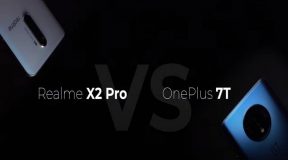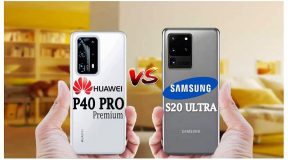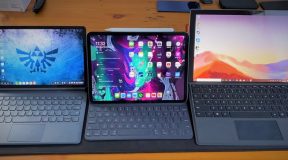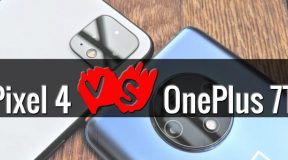Dear gadgets lovers, if you’ve spent the last couple of years with an iPod pro, you’ll know that Apple’s definition of pro seems to vary. it was the Apple Pencil which separated the pro from the amateur, a direct bowed to the Samsung Galaxy Note that kept believing in a feature that Steve Jobs once mocked. The irony is that Samsung has never really called its note a pro, even if it advertises it as made for professionals. So I guess there’s only one way to know which one is the right kind of pro for you. I’m high Metairie better with pocket now. And this is the iPhone 11 Pro vs. Samsung Galaxy Note 10. The most common question that I get in the comments in which the vices my daily driver and it’s usually the same answer, it’s whatever small iPhone is out, plus whatever Galaxy Note is out this time. And for this particular comparison, because we have a smaller Galaxy Note, I decided to make this comparison fair, mainly because both devices are priced the same. So it’s always good to know which Variant gives you more bang for those 1000$. Size-wise, it’s quite shocking to see that both devices aren’t really that much different.
Table of Contents
Specification:

Design:
The galaxy just seems slightly larger because of its boxy design, but it’s actually just 7 millimeters taller than they’re both almost just as wide and just as thick. the iPhone is a crazy 20 grams heavier. If you’re wondering why it’s most likely got to do with the stainless steel frame apple uses versus the aluminum on the galaxy Note10. They actually both look similar when it comes to their finish, but the stainless steel will be more resilient to a fall than the aluminum, though also more prone to micro scratches when compared to the latter. I have to hand it to Cupertino for this frosted finish on the back glass. It does a significantly better job of selling fingerprints in the galaxy. Note 10 Apple doesn’t really provide a rating for its class, but it claims to be the strongest available.

Build quality:
The Samsung galaxy note 10 made by Corning, just like the gorilla glass 6 on the note. Overall, both devices offer great build quality, but I’ll give more points to Apple for its stainless steel. Now internals is more of a mixed bag and I shouldn’t even compare them. I mean, ISIS is not a specked country as Android is. Still, there are some substantial differences in what you get for the same money on either phone. Aside from the processor differences for Galaxy Note 10 will give you double the ram and four times more storage. 256 gigabytes versus a meager 64. There’s also a 13 percent larger battery and support for faster wireless charging. Everything else from the IP rating to the Wi-Fi and the Bluetooth version are all the same thing as you really don’t have to be a spec had to know that Samsung wins this one. And it’s mainly because if you want to get the same amount of storage on the iPhone, that’s an extra $250.

Display:
if you were to follow the marketing, you’d assume that Apple’s display is significantly better. Apple made a huge deal about their new pro display, HDR, because it can go up to twelve hundred meds of brightness in certain scenarios and has a crazy 2 million to 1 contrast ratio. if you want to know which other device has those exact same specifications, it’s actually the Galaxy Note 10. Samsung makes Apple’s display. they’re dynamic AMOLED. It was actually the first to provide all this brightness and contrast and with the benefit of a larger 6.3-inch canvas versus 5.8. The only reason why I give this one to Apple is because of the added resolution. I actually never thought that I’d say that I could tell the difference between 4:58 PBI and for a one. But you actually can. 
if you look closely, the iPhone’s display just looks sharper. But then there’s the feature that the iPhone just doesn’t have. And it’s the welcomed digitizer on the display that enables the Espin to do its thing. Stylish input wasn’t invented by Samsung, but man, have they perfected it. Using the Espin feels like using a sharpie on a piece of paper. And this is the first time that you don’t need a behemoth of a phone to have it available to you within the phone’s body. This alone is a definite win for Samsung.
Software Innovation:
There’s also the topic of software. One UI is not necessarily my favorite user interface, but it’s really what makes a note. A note. It seems that Samsung did a lot of homework when it came to how a user would naturally use a notepad and mimicked it perfectly with this device. See, for example, that you want to take a quick note there, screen off memos. You don’t have to even jump within the application. So you want to use Microsoft one-note or Microsoft Excel, highlight a few things within your spreadsheet and point them out. You actually can with this phone, want to have your favorite app combinations on split windows shortcuts that you can launch from the screen. You actually can with the note, even if you want it to have some basic things like widgets on your screen.
You can with the Galaxy Note and sadly you can do absolutely none of this on ISIS. Surely it’s more simplistic in its approach to software. And I know that there are people that want that, that they just want a phone to be a phone. But I’d say that these people are actually missing out. Samsung just demolishes Apple when it comes to the added functionality of the software. About the only spot where I feel that Apple swings back as in the fact that you have no clue when Samsung will give you a software update while Apple’s even offering IOS 13 to phones that are 4 years old on the same day as the new ones. And then there’s the case of battery life where neither of these two phones were designed to be a battery. King says you’ve got the choice to grab their larger siblings. Still, I feel that Apple is doing a better job at more efficient power management. I also prefer phone calls on the iPhone, but not necessarily because it sounds better, it’s just that the Tifton earpiece on the Galaxy makes it hard for you to find exactly where to place your ear, whereas, in the case of the iPhone, the earpieces exposed because of them not.
Fingerprint/Biometric Technology:
They are really no confusion here. And if we were to compare biometrics, I will admit that I also prefer Apple’s face unlocking, over Samsung’s on-display fingerprint scanner and not because it’s better, Samsung’s ultrasonic fingerprint scanner is just to secure. The problem is it’s not as fast as face I.D. And sure, you do have face to unlock on the galaxy, but it’s not as secure as this offering. And also, keep in mind that you’re not buying either of these phones for their headphone jacks because there aren’t any. And you’re not getting any dongles in either of the boxes.
Camera Technology:
Where the comparison gets heated is once you make the fight about the cameras in the past, Samsung would just obliterate iPhones in so many ways. But this year, the tables have turned dramatically. Apple has been working hard on its computational HDR since the iPhone 10 s and it shows in most cases I like the iPhone’s choice for more subtle colors and saturation and the fact that it doesn’t overdo the detail. But Samsung hasn’t been sitting on its laurels either. Note 10 in most cases provides a photo that’s just as good or sometimes slightly better.
Each device offers the versatility of three focal lengths for their primary cameras. But this is where things start tipping towards the iPhone. Apple’s HDR tuning has extended to have all 3 camera sensors provide the same color and exposure while the galaxy doesn’t always achieve this. The same goes for the ultra-wide, where I feel that Apple handles lens distortion better than the galaxy. Both devices have a night mode, but each has its own pros and cons seat. The iPhone allows you to manually time how much low light exposure you want, but then doesn’t offer night mode in the ultra-wide, which is just ridiculous. The galaxy doesn’t offer time but offers a night mode on all lenses. Really, the only reason I give points to Samsung is mainly that you have manual controls so you can control absolutely everything if you really wanted to. then the same goes for portrait photos where I do feel that the iPhone does a better job in skin tones, options, and overall results. But then the galaxy at least gives you the option to completely remove the portrait mode if you don’t like the results after the fact. And this actually goes for both selfies and portrait shots. And since we already began talking about selfies, I really can’t determine a winner in both.

Apple has now adopted a wider angle, but so has Samsung for the last three generations of Galaxy. So if anything, I’ll say Apple. Welcome to the ballgame. Really where the iPhone wins. This one is in the video, for example. Both devices are capable of doing 4K selfie video with 30 frames per second, but only the iPhone can do 4K at 60 with the selfie camera.
And if we were to measure stabilization, the iPhone almost seems like if you’re using a gimbal where the galaxy is good but not as good. And it’s the same story with shooting video from the primary cameras. Both are capable of 4K at 30 and you can use all three focal lengths so long as you remain in these settings. Now if you wanted to go 4K at six, only the iPhone can use all three focal lengths. The galaxy is sadly limited to the primary camera only. And even if the galaxy is not bad about stabilization, the super study only works at 10 ATP. The iPhone, on the other hand, doesn’t even have a mode. The video looks like if it was stabilized by a Gimbel no matter what focal length you use. To conclude, let me just say that there was no way that this comparison was not going to be difficult. Both devices are premium offerings and both pull their own weight when it comes to their capabilities and what makes them special. The iPhone owns the build quality. The Galaxy owns the specs for the price. Both have the best displays in the market. And Samsung owns software thanks to all the benefits of the Espin. All while the comparison gets tight in the camera and we’re Apple only win by a tight margin thanks to its video recording capabilities. So which one to pick? This is one of those moments where I’m glad that I don’t have to.
Final Talks
I actually carry both the larger Samsung Galaxy Note 10 and Plus and the iPhone 11 pro are my two daily drivers. I promise that I’ll declare a winner. But let me start by saying that if you’re looking for more creative work, vlogging, video, photography and stuff. I’d give the iPhone 11 pro a shot over the galaxy. Now, if you prefer more of a productivity device, notes, calendar and stuff and sure, a little photography here and there, then that’s where the Galaxy Note is best at. The thing is if I only had to pick one. And even if it would be the smaller Galaxy Note 10, I think that this is actually the better by certainly no phone should cost 1000$. But if I’m willing to pony up so much money, I’d rather get my money’s worth with some added value with the tenure. Get the s pen and four times more storage. This alone are enough to make me wonder why Apple is still willing to charge so much for just the better-looking phone. Now, which one would you pick? Let us know in the comments down below. And while you’re at it, share this article on social media if you like. Subscribe us for more articles like this one. Thank you so much for reading this out. We’ll see you on the next one.






